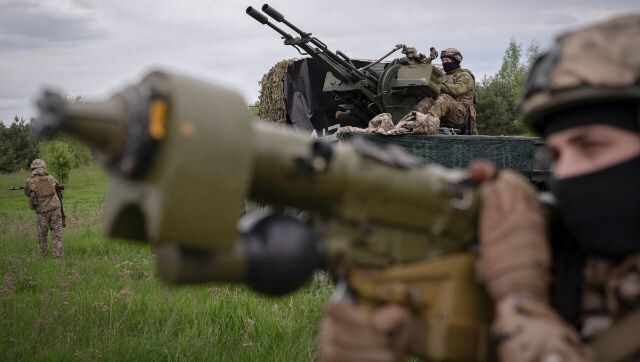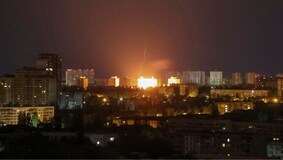With help of Western weapons, growing experience Ukraine's air defences make strides against Russian onslaught
Since 28 April, Russia has fired a total of 67 missiles and 114 drones at Ukraine, according to Ukrainian air force reports. Only seven missiles and 11 drones got through, and none hit Kyiv

Members of a Ukrainian air-defense unit demonstrate their work near Kyiv. AP
When air-raid sirens warning of an impending Russian attack are heard by inhabitants of Kyiv, Ukraine’s air-defence battalions have already left. They dash out by vehicle to farm areas near the capital from concealed positions, ready to shoot down hostile drones or missiles.
Since Russia started frequent air assaults on Kyiv on 28 April after an almost two-month pause, the scramble has practically become a nightly occurrence. Since then, every drone and missile fired against the capital has been intercepted by the forces.
It represents a significant improvement over the early stages of the conflict when waves of Russian missiles and planes evaded many Ukrainian defences and severely damaged Kyiv’s air force.
Related Articles
With the help of Western weapons and growing experience, Ukraine’s air defences have made great strides in the past 14 months, saving infrastructure and lives and preventing Russia from achieving air superiority — a critical step as Ukrainians prepare for a counteroffensive.
The bolstered defences have deterred Russian aircraft from going deep behind the front lines and “greatly shaped the course of the war,” Ian Williams wrote this month in an analysis for the Center For Strategic and International Studies, or CSIS.
Since 28 April, Russia has fired a total of 67 missiles and 114 drones at Ukraine, according to Ukrainian air force reports. Only seven missiles and 11 drones got through, and none hit Kyiv.
Last week, Kyiv units reported they had shot down Russia’s most advanced hypersonic missile, a weapon that was previously considered unstoppable by Ukraine. A newly acquired American-made Patriot battery made it possible.
On the first day of the invasion, Russia targeted Ukraine’s ground-based air-defence systems, first with a wave of missiles, then with dozens of bomber sorties supported by electronic warfare measures that essentially blinded Ukrainian radar, wrote Justin Bronk in an April analysis for the Virginia-based Center for Naval Analyses.
But Ukraine had received intelligence from allies ahead of the Russian attacks, allowing Ukrainian defenders to move mobile units out of harm’s way, although some fixed positions were destroyed.
The units were scattered, and for a brief time, Russia was able to fly in waves of helicopters, supported by fighter jets, and inflict heavy losses on Ukrainian aircraft sent to intercept them.
But the Russians failed to follow up on their initial attacks, allowing Ukraine to regroup quickly, said Douglas Barrie, a defence aerospace specialist with the International Institute for Strategic Studies in London.
“They didn’t go back and check: Did we destroy it? Disable it? Do we need to go back and do it again? Have they relocated?” he said.
The brigade commander of the air defence command “Center” is a colonel who could only be identified by his callsign, “Granite,” in keeping with the Ukrainian military’s policy of protecting soldiers’ identities. During a visit by The Associated Press to his unit this week, he said his brigade was hit on the first day of the war with 20 Russian missiles, which took out barracks and command posts and killed people.
After abandoning fixed positions, they now operate strictly as mobile teams that can quickly spring into action and just as quickly slip away — a tactic commonly referred to as “shoot and scoot.”
After the initial setbacks suffered by Ukraine’s air defences, enough mobile units were back in operation by the war’s third day that they were able to shoot down multiple planes, prompting Russia to pull back its attack aircraft and deprive it of a key advantage.
But many of the Russian missiles were still getting through.
Granite estimates in the early months that Ukraine was intercepting about 50 per cent of incoming Russian missiles. The CSIS report suggested the figure might actually have been much lower.
With the arrival of new Western-made air defence systems in October and November, as well as the growing skill of the Ukrainian batteries, Ukraine reported intercepting some 80 per cent of incoming Russian cruise missiles by December.
Today, Granite said the figure is closer to 90 per cent, and he said the defence systems around Kyiv have taken down 100 per cent of missiles shot at the city since 28 April.
“Kyiv is protected,” he said.
Two key systems used by Ukraine since the start of the war have been the Soviet-era long-range S300 and medium-range Buk systems, also known as the SA-10s and SA-11s.
Ukraine has gradually added new systems from Western allies, including IRIS-T batteries from Germany in October and the American and Norwegian-built NASAMS in November.
It has also received European-built SAMP/T systems, and American-built HAWK missiles, and last month added two US-built Patriot batteries.
The air defence teams are set up with overlapping range rings, starting from short, almost point-blank defences using shoulder-launched missiles and anti-air cannons to greater distances.
A single layer would not be enough to stop all strikes or even most of them, Barrie said. “But the more layers you have, the greater the chances you have.”
Though all recent attacks on Kyiv have been thwarted, debris from falling missiles and drones has caused injuries and damage in the capital. But that is nothing compared with what could have happened, Granite said. In the 28 April attacks, a missile hit an apartment building in the central city of Uman, killing 23.
With so many Russian assaults, some speculate that Moscow’s strategy is to try to deplete Ukraine’s air defence resources to the point where Russia will again be able to exploit its advantage with fighters and bombers. But there are also signs that Russia is running lower on missiles.
So far Ukrainian President Volodymyr Zelenskyy has successfully pressed allies for more air-defense supplies. The US on Monday announced $1.2 billion more in long-term military aid, including new HAWK systems, drones and air-defence munitions.
Moscow could also be banking that Western support will eventually wane and put pressure on Ukraine to make concessions, Williams wrote.
Morale seemed high among Granite’s troops this week, as a short-range team clowned around despite being on duty long into the early morning hours as Kyiv’s air defences took down 35 explosive Iranian-made Shahed drones. The team then scrambled back to their posts around midday for what turned out to be a false alarm.
“Beetle,” who took down a Russian helicopter over Kyiv on the first day of the war with a shoulder-launched missile, said the success gave him confidence that he still holds.
“I realized that it’s not over yet, that we can fight,” he said. “So they’re not that scary.”
“Range,” a driver who joined the military on the first day of the war after seeing missiles rain down, said he could not sit on the sidelines.
“It’s history,” he said. “And we’re currently writing it.”
Read all the Latest News, Trending News, Cricket News, Bollywood News,
India News and Entertainment News here. Follow us on Facebook, Twitter and Instagram.
also read

Who is to blame for the drone attack on the Kremlin?
Unverified video footage circulating on social media appears to show an explosion on the domed roof of a building known as the Kremlin Senate, which houses the presidential administration, though the exact target and perpetrator remain unknown

‘Ukrainian bullets did not kill Russian soldiers, bad first-aid did’
In the Russian invasion of Ukraine, over half the Russian soldiers who died lost their lives due to improper first aid in the field; over a third of amputations due to wrong use of tourniquets

Racial Cleansing: Moscow turning captured parts of Ukraine into mini-Russia
The Russian military is continuing with a campaign to depopulate areas of Ukraine under its control and bring in people from the poorer regions of Russia to settle in those regions


